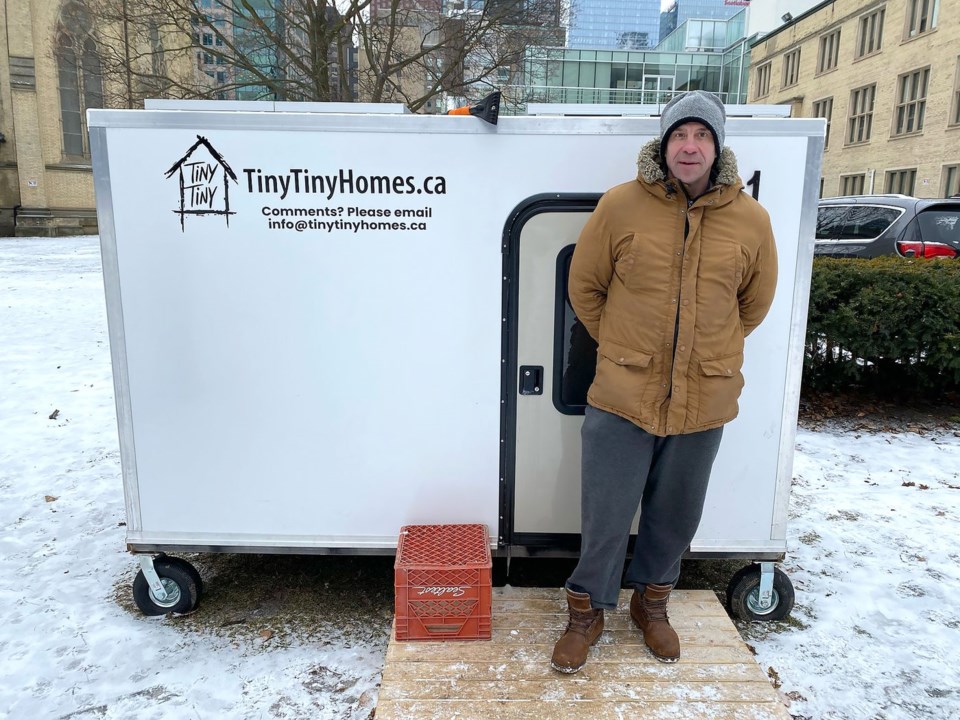TORONTO — Samu Nauel has been mostly homeless since moving to Canada from Hungary in 2023 and applying for asylum.
He was able to stay in a Toronto hotel for a while, but eventually got kicked out. Then on Jan. 15 – the day his asylum application was accepted – Nauel received the key to a tiny home, a portable white camper in a downtown park.
“I sleep well, you know, have a bed … I have like a small table,” the 50-year-old said a week after he moved into the emergency shelter in St. James Park.
“It is amazing.”
Less than a month later, the City of Toronto has asked Tiny Tiny Homes, the non-profit behind the project, to remove the five small shelters in the park, a move that might leave Nauel homeless once again.
Spokesperson Russell Baker said the city has told the founder of Tiny Tiny Homes that the structures cannot remain at St. James Park, which is city-owned property.
Baker said in an email Friday that while the city appreciates Torontonians who care about people in need, the tiny shelters pose safety risks for those living inside and near them, and interfere with public use of the park as well as city staff's outreach work.
"While the city plans to report later this year on the feasibility of using micro shelters to augment ongoing shelter system expansion, they are currently not permitted on any city-owned properties," he wrote.
Ryan Donais, a construction worker who founded Tiny Tiny Homes, said he started building the shelters with the goal of ending homeless encampments that have grown across Ontario in the past few years.
“Around last spring (was) where I'm like, 'You know what, this is enough. I'm going to do something,' and I decided to make my first one,” he said in an interview at St. James Park last month.
Each tiny home is made of fibreglass, and has a bed and a small kitchen, a solar panel on the roof to power lights and a fan, and a diesel-fuelled heating system. The structures can be towed easily.
Donais said that while he has only built a few units, he believes what he started has the potential to end encampments in Toronto and beyond.
“Nobody should be in a tent in Canada,” he said.
In an update on its website, Tiny Tiny Homes says the city might consider legal or enforcement steps to remove the structures from St. James Park. It is asking people to sign a petition urging the city to find alternative locations for the shelters.
"Forcing the removal of emergency shelters does not solve the city’s homelessness crisis. Nor does it ensure the safety or dignity of our homeless neighbours or even remove them from public spaces," reads the petition, which has garnered more than 22,000 signatures. "The city has both legal and moral obligations to address homelessness."
All five tiny shelters, with red and purple heart stickers on them, were still in the park as of Friday afternoon.
Diana Chan McNally, who has been working with homeless people in Toronto for a decade, said the city has a long history of well-meaning people coming up with innovative solutions but they have mostly been ignored, and even criminalized in some cases.
Khaleel Seivwright, a carpenter who built approximately 100 small cabins for homeless people during the COVID-19 pandemic, agreed to stop installing new shelters on city land or relocating the ones he had already built after a legal fight with the city.
Chan McNally said while providing housing is the only permanent solution, initiatives such as tiny homes are needed to tackle the issue in the immediate future.
"Given the crisis of homelessness that is across Canada, we do need these kinds of interim solutions, which are quick to do and relatively inexpensive so that at least people can have some kind of shelter instead of nothing," she said in an interview last month.
In some city shelters, dozens of strangers live in one large room, which can create an unsafe and unhealthy environment, she added.
The city needs to embrace initiatives such as tiny homes and provide a place for portable shelters, she said.
Chan McNally's view was echoed by Jody Steinhauer, the founder of outreach organization Engage and Change.
“People are not in encampments because they wanna go winter camping,” she said last month. “They're in encampments because if they walk up to a shelter, there are no beds, so if they can't get in a shelter and it's freezing cold, where do we expect them to go?”
On an average night in 2024, the city said it sheltered about 12,200 people, up from 10,700 people the previous year.
Steinhauer called on the city to provide a space for the tiny homes.
“Give them a beautiful trailer park that's got a nice fence around it, and it's got a community centre with social workers and health care and whatever else they need.”
She said tiny home projects benefit communities where encampments are located and provide a path toward financial independence.
“Once they have a stability of knowing they have warm bed to sleep in every night, then they can take the next step and potentially get housed and get a job,” she said.
This report by The Canadian Press was first published Feb. 14, 2025.
Sharif Hassan, The Canadian Press
